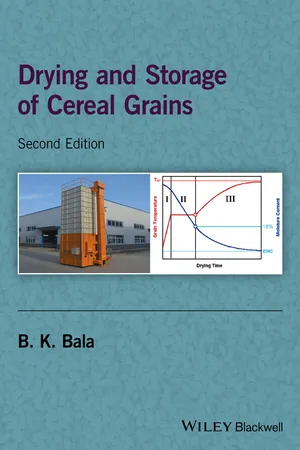
- English
- ePUB (mobile friendly)
- Available on iOS & Android
Drying and Storage of Cereal Grains
About this book
Finite Element Analysis and Computational Fluid Dynamics have been introduced in modelling and simulation of drying and storage systems, these techniques are expected to dominate the future research and development of drying and storages, and should reduce losses and improve the quality of agricultural products, enhancing food security globally.
Drying and Storage of Cereal Grains, Second Edition, covers the wide spectrum of drying and storage methods applied to economically important cereal produce, providingnumerical examples for better understanding the complexity in drying and storage systems through modelling and simulation, aiding design and management of drying and storage systems. Chapters 1 to 8 look at air and grain moisture equilibria, psychrometry, physical and thermal properties of cereal grains, principles of air flow, and provide detailed analyses of grain drying.Chapters 9 to 13 focus on temperature and moisture in grain storages, and provide comprehensive treatment of modern grain storage systems. The book also includes a number of unsolved problems at the end of each chapter for further practice.
This revised second edition includes new sections on -
- heat of sorption
- finite element modeling of single kernel
- CFD modeling of fluidized bed drying
- exergy analysis and neural network modeling
- numerical solution of two dimensional temperature and moisture changes in stored grain
This book will provide students in agricultural engineering and food engineering with a wide spectrum of drying and storage studies previously unavailable in a single monograph. It will also serve as an excellent reference for practicing agricultural engineers, food engineers and food technologists.
Frequently asked questions
- Essential is ideal for learners and professionals who enjoy exploring a wide range of subjects. Access the Essential Library with 800,000+ trusted titles and best-sellers across business, personal growth, and the humanities. Includes unlimited reading time and Standard Read Aloud voice.
- Complete: Perfect for advanced learners and researchers needing full, unrestricted access. Unlock 1.4M+ books across hundreds of subjects, including academic and specialized titles. The Complete Plan also includes advanced features like Premium Read Aloud and Research Assistant.
Please note we cannot support devices running on iOS 13 and Android 7 or earlier. Learn more about using the app.
Information
1
Principles of Drying
1.1 Introduction
1.2 Losses of Crops
1.3 Importance of Drying
- Drying permits the long-time storage of grains without deterioration of quality.
- Drying permits farmers to have better-quality product for their consumption and sale.
- Drying permits the continuous supply of the product throughout the year and takes advantage of higher price after harvesting season.
- Drying permits the maintenance of viability and enables the farmers to use and sell better-quality seeds.
- Drying permits early harvest which reduces field damage and shatter loss.
- Drying permits to make better use of land and labour by proper planning.
1.4 Principles of Drying
Reference
- Majumder, S., Bala, B.K., Fatimah, M.A., Hauque, M.A. and Hossain, M.A. 2016. Food security through increasing technical efficiency and reducing post harvest losses of rice production systems in Bangladesh. Food Security, 8(2): 361–374.
Further Reading
- Adams, J.M. 1977. A review of the literature concerning losses in stored cereals and pulses published since 1964. Tropical Science, 19(1): 1–28.
- Bala, B.K. 1997. Drying and storage of cereal grains. Oxford & IBH Publishing Co, New Delhi.
- Hall, C.W. 1980. Drying and storage of agricultural crops. AVI Publishing Company Inc, Westport, CT.
2
Moisture Contents and Equilibrium Moisture Content Models
2.1 Introduction
Table of contents
- Cover
- Title Page
- Table of Contents
- Foreword to the Second Edition
- Foreword to the First Edition
- Preface
- 1 Principles of Drying
- 2 Moisture Contents and Equilibrium Moisture Content Models
- 3 Psychrometry
- 4 Physical and Thermal Properties of Cereal Grains
- 5 Airflow Resistance and Fans
- 6 Thin Layer Drying of Cereal Grains
- 7 Deep-Bed and Continuous Flow Drying
- 8 Grain Drying Systems
- 9 Principles of Storage
- 10 Temperature and Moisture Changes During Storage
- 11 Fungi, Insects and Other Organisms Associated with Stored Grain
- 12 Design of Grain Storages
- 13 Grain Storage Systems
- Appendix A: Finite Difference Approximation
- Appendix B: Gaussian Elimination Method
- Appendix C: Finite Element Method
- Appendix D: Computational Fluid Dynamics
- Index
- End User License Agreement